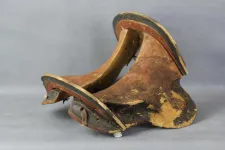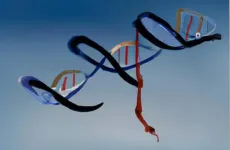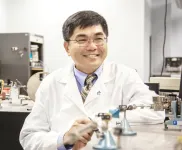(Press-News.org)
In April 2015, looters sacked an ancient cave burial at a site called Urd Ulaan Uneet high within the Altai Mountains of western Mongolia. When police apprehended the criminals, they uncovered, among other artifacts, an elegantly carved saddle made from several pieces of birch wood.
Now, in a new study, researchers from Mongolia collaborating with University of Colorado Boulder archaeologist William Taylor have described the find. The team’s radiocarbon dating pins the artifact to roughly the 4th Century C.E., making it one of the earliest known frame saddles in the world.
“It was a watershed moment in the technological history of people and horses,” said Taylor, corresponding author of the new study and curator of archaeology at the CU Museum of Natural History.
He and his colleagues, including scientists from 10 countries, published their findings Dec. 12 in the journal Antiquity.
The research reveals the underappreciated role that ancient Mongolians played in the spread of horse riding technology and culture around the globe. Those advances ushered in a new and sometimes brutal era of mounted warfare around the same time as the fall of the Roman Empire.
The discovery also highlights the deep relationships between human and animals in Mongolia. For millennia, pastoral peoples have traveled between the vast grasslands of the Mongolian Steppe with their horses—which, in the region, tend to be short but sturdy, capable of surviving winter temperatures that can plummet far below freezing. Airag, a lightly alcoholic beverage made from fermented horse milk, remains a popular libation in Mongolia.
“Ultimately, technology emerging from Mongolia has, through a domino effect, ended up shaping the horse culture that we have in America today, especially our traditions of saddlery and stirrups,” Taylor said.
But these insights also come at a time when Mongolia’s horse culture is beginning to disappear, said study lead author Jamsranjav Bayarsaikhan.
“Horses have not only influenced the history of the region but also left a deep mark on the art and worldview of the Nomadic Mongols,” said Bayarsaikhan, an archaeologist at the Max Planck Institute for the Science of Human History in Germany. “However, the age of technology is slowly erasing the culture and use of horses. Instead of herders riding horses, more and more people are riding motorcycles in the plains of Mongolia.”
Mounted combat
Bayarsaikhan was working as a curator at the National Museum of Mongolia when he and his colleagues got the call from police in Hovd Province. The team later excavated the Urd Ulaan Uneet cave and unearthed the mummified remains of a horse, which the group partially described in a 2018 paper.
The saddle itself was made from about six pieces of birch wood held together with wooden nails. It bears traces of red paint with black trim and includes two leather straps that likely once supported stirrups. (The researchers also reported an iron stirrup recently discovered from around the same time period in eastern Mongolia).
The group couldn’t definitively trace back where those materials came from. Birch trees, however, grow commonly in the Mongolian Altai, suggesting that locals had crafted the saddle themselves, not traded for it.
Taylor explained that humans had used pads, a form of proto-saddle, to keep their rear ends comfortable on horseback since the earliest days of mounted riding. Rigid wooden saddles, which were much sturdier, paired with stirrups opened a new range of things that people could do with horses.
“One thing they very gave rise to was heavy cavalry and high-impact combat on horseback,” Taylor said. “Think of jousting in Medieval Europe.”
Traveling west
In the centuries after the Mongolian saddle was crafted, these types of tools spread rapidly west across Asia and into the early Islamic world. There, cavalry forces became key to conquest and trade across large portions of the Mediterranean region and northern Africa.
Where it all began, however, is less clear. Archaeologists have typically considered modern-day China the birthplace of the first frame saddles and stirrups—with some finds dating back to the 5th to 6th Century C.E. or even earlier.
The new study, however, complicates that picture, Taylor said.
“It’s not the only piece of information suggesting that Mongolia might have been either among the very first adopters of these new technologies—or could, in fact, be the place where they were first innovated,” he said.
He suspects that Mongolia’s place in that history may have gone underappreciated for so long in part because of the region’s geography. The population density in the country’s mountainous expanses is low, among the lowest on Earth, making it difficult to encounter and analyze important archaeological finds.
Bayarsaikhan, for his part, calls for more archaeological research in the nation to better tell the story of horses in Mongolia.
“Mongolia is one of the few nations that has preserved horse culture from ancient times to the present day,” he said. “But the scientific understanding of the origin of this culture is still incomplete.”
END
UNIVERSITY PARK, Pa. — Self-propelled nanoparticles could potentially advance drug delivery and lab-on-a-chip systems — but they are prone to go rogue with random, directionless movements. Now, an international team of researchers has developed an approach to rein in the synthetic particles.
Led by Igor Aronson, the Dorothy Foehr Huck and J. Lloyd Huck Chair Professor of Biomedical Engineering, Chemistry and Mathematics at Penn State, the team redesigned the nanoparticles into a propeller shape to better control their movements and increase their functionality. ...
Karandeep Singh, MD, has been recruited as the Joan and Irwin Jacobs Endowed Chair in Digital Health Innovation at University of California School of Medicine and named as the inaugural chief health artificial intelligence (AI) officer at UC San Diego Health, a newly developed position for the region’s only academic medical center.
This new role will be effective December 29, 2023.
In this position, Singh will focus on implementing change that advances safety and health outcomes in acute and ambulatory settings. His contributions will be pivotal in bringing innovation to ...
NEW YORK, NY--Many Black Americans who are thought to have a high risk of developing kidney disease possess a protective genetic variant that nullifies the extra risk, a new study from Columbia researchers has found.
The study found that high-risk people who carry this variant have a risk of developing kidney disease much closer to that of the general population.
The findings will have an immediate impact on clinical practice, says study leader Simone Sanna-Cherchi, MD, associate professor of medicine at Columbia’s Vagelos College of Physicians and Surgeons.
“Physicians ...
FOR IMMEDIATE RELEASE
Using a “liquid biopsy” to study genetic material from tumors shed into the bloodstream together with immune cells could help clinicians predict which patients with advanced lung cancers are responding to immunotherapies and which patients may develop immune-related side effects several months later, according to research directed by investigators at the Johns Hopkins Kimmel Cancer Center, the Bloomberg~Kimmel Institute for Cancer Immunotherapy and Allegheny Health Network Cancer Institute in Pittsburgh.
By monitoring changes in circulating tumor DNA (ctDNA) among 30 patients treated with immunotherapies for metastatic non-small cell lung cancers, ...
WASHINGTON, DC, 2023, December 12, 2023 – The problem of foodborne metal contamination has taken on new urgency, thanks in part to a 2021 US Congressional Report detailing high levels of metals found in infant food pulled off grocery shelves. (More recently, high levels of lead were discovered in children’s fruit puree pouches.) Now, two new studies provide information on the correlation between exposure to heavy metals in food and the risk of cancers and other serious health risks. The findings will be presented ...
Artificial intelligence (AI) systems are often depicted as sentient agents poised to overshadow the human mind. But AI lacks the crucial human ability of innovation, researchers at the University of California, Berkeley have found.
While children and adults alike can solve problems by finding novel uses for everyday objects, AI systems often lack the ability to view tools in a new way, according to findings published according to findings published in Perspectives on Psychological Science, a journal of ...
Physician-scientist Omar Abdel-Wahab, MD, is being honored at the 2023 American Society of Hematology (ASH) Annual Meeting with the William Dameshek Prize, which recognizes individuals who have made outstanding contributions to the field of hematology. The award will be presented December 12.
Dr. Abdel-Wahab, who chairs the Molecular Pharmacology Program at Memorial Sloan Kettering Cancer Center (MSK), was selected for his “trailblazing research” characterizing the genetic mutations that drive blood ...
A new study out of the Johns Hopkins Medicine Lyme Disease Research Center has revealed disparities in the diagnosis and treatment of Lyme disease between Black and White patients with the condition. Researchers say the data, which draws on participants’ medical histories, whether from Johns Hopkins Medicine or other institutions, highlights issues in the nation’s medical education on Lyme disease.
In the full article, published December 12 in JAMA Network Open, researchers say that Black patients were more likely to have advanced stages of Lyme disease when clinically diagnosed and also experience a longer time before receiving antibiotic treatment for the condition.
Lyme ...
DALLAS (SMU) J.-C. Chiao, the Mary and Richard Templeton Centennial Chair and professor in the Electrical and Computer Engineering Department in the SMU Lyle School of Engineering, has been named a fellow of the National Academy of Inventors (NAI).
Election as an NAI fellow is the highest professional distinction awarded to academic inventors. The NAI Fellows Program highlights academic inventors who have demonstrated a spirit of innovation in creating or facilitating outstanding inventions that have made a tangible impact on quality of life, economic development and the welfare of society.
Chiao, one of 162 inventors selected for the ...
The ability to transmit information coherently in the band of the electromagnetic spectrum from microwave to infrared is vitally important to the development of the advanced quantum networks used in computing and communications.
A study conducted by researchers at the State University of Campinas (UNICAMP) in Brazil, in collaboration with colleagues at ETH Zurich in Switzerland and TU Delft in the Netherlands, focused on the use of nanometric optomechanical cavities for this purpose. These nanoscale resonators promote interaction between high-frequency ...







